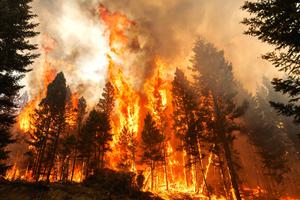Last December, the French government announced the first group of foreign scientists to be awarded grants under its Make Our Planet Great Again program, French President Emmanuel Macron’s pointed response to Donald Trump’s move to pull out of the Paris Agreement on climate change. U.S. scientists, Macron had said, should come to France to “work together on concrete solutions for our climate.”
Among the first group of 18 researchers is Ben Sanderson, a project scientist at the National Center for Atmospheric Research in Boulder, Colorado. In September, Sanderson will be heading to a climate laboratory in Toulouse, where he has received a five-year, $1.8 million grant to continue his work on modeling climate change and communicating those risks to society. Of the 18 researchers who will be moving to France, 13 are from United States universities and research institutions.
In an interview with Yale Environment 360, Sanderson says that the option to take his research overseas became attractive when his work got the cold shoulder from federal funding agencies after the Trump administration took office. “I wrote a couple of proposals that year and found that there was definitely a nervousness for funding science that had… direct relevance to the consequences of [CO2] emissions,” says Sanderson. Lending urgency to his move, Sanderson says, is the reality that the Trump administration’s inaction comes at a critical moment when carbon emissions continue to soar and the hope of limiting warming to 1.5 degrees Celsius above pre-industrial levels is rapidly fading.
Yale Environment 360: Why take your research to France, and was there a moment of no return for you regarding that decision?
Ben Sanderson: First, as I think everybody working in science and people working in other fields after the election, I was initially very concerned about what this would mean for research. Just simply the fear that science was going to be suppressed had an effect, before there were really any top-down changes in the administration at all. Funding agencies, people managing major labs and deciding which proposals should be funded, started to be more cautious about the kind of language they wanted in proposals and about the type of science they wanted in proposals. That effect became very apparent, especially during the first year of the administration, when nobody really knew what was going on.
I wrote a couple of proposals that year and found that there was definitely a nervousness for funding science that had direct societal applications or direct relevance to [CO2] emissions and the consequences of emissions. There was a preference for the kind of project that was purely theoretical, purely physical science, without really thinking about how that connects back to society, both in terms of thinking about [climate change] scenarios and what humanity might do moving forward, and thinking about how climate simulations relate back to impacts and decision-making on the adaptation side. We’ve seen funding institutions and labs pull back from being on the front line of that. That’s not to say that that kind of work isn’t happening at all in the U.S. It is, but people are more nervous about highlighting it and funding it further.
“It was very difficult to do the type of work that I wanted to do, which was trying to shine more light on climate risk assessment.”
From the personal perspective, that meant that it was very difficult to do the type of work that I wanted to do, especially the direction I wanted to move in, which was trying to shine more light on climate risk assessment in light of full recognition of the uncertainties of climate models. Writing those kinds of proposals, which are implicitly about society as well as about physical climate, was hard, and I was told that the proposals at the moment have to be less societally focused.
e360: Were you told that by funders who were saying, “This is not going to fly in this climate?”
Sanderson: By funding agencies.
e360: What funding agencies?
Sanderson: I’d rather not say which funding agencies, but that was definitely the message that was communicated back, that it’s fine to do climate science that is purely academic, but producing science that has potential political ramifications was not going to be encouraged.
French President Emmanuel Macron, with President Donald Trump, on a visit to the White House in April. Shealah Craighead / White House
e360: If this opportunity in France had not arisen, it sounds like you would have been pushed back into an area of research that you wanted to move beyond, and if you didn’t, you would have been twiddling your thumbs.
Sanderson: Since all of that happened in the first year, I think there’s actually been a little bit of a step back from that position now. I think that’s for a couple of reasons: In the agencies, during the first year, there were political appointees who were assessing everything, every proposal being put forward, and I don’t think that’s the case anymore. Then there’s also a realization that it’s actually difficult to sell climate science that has no connection back to society, even on a government level, even in the present climate. If you don’t give a Congressperson a reason to care about the science, if you don’t say, “Well, if we do this type of work, then it’ll improve our understanding of forest fires in your state,” for example, then that sort of argument provides a hook, provides a reason for politicians to become invested in the type of science that comes out of climate models.
e360: You’re relatively outspoken for a scientist. You’ve written various opinion pieces, including one for the Washington Post, in which you criticized the Trump administration’s decision to withdraw from the Paris Agreement. Why make such public pronouncements, and when you do, what kind of reaction do you get from colleagues?
Sanderson: When I’ve written for the popular press, I’ve tried to not put any opinions in there. All I’ve really tried to do is communicate what we know as a scientific community about the certain consequences of missing emission targets, and that’s hard science, very well established. I feel like, in clear cases like this with the consequences of a major emitter like the U.S. completely ignoring the Paris Agreement for the next couple of decades, then the science as we know it has really clear things to say about what the consequences of that decision would be. It’s not even a political statement, it’s just a statement of cause and effect. If emissions remain at or above present-day levels for the next 15 years, then we can put numbers on how much warming that’s going to translate into. And I think that kind of message very rarely gets through to the general public. That’s why I made the decision that it was worth writing such a piece. Even though it might be construed as being an opinion, I don’t see it as such. It’s just a statement of the science that we’re really confident about.
“In order to hit 1.5 degrees, every bit of carbon that is put into the atmosphere now has to be taken out again at some point in the future.”
e360: Shortly after President Trump’s election, you and a colleague wrote a commentary for Nature Climate Change entitled “Delays in U.S. Mitigation Could Rule Out Paris Targets,” and in that commentary you wrote of the Trump administration’s threat to pull out of the Paris agreement: “A naive assessment of a brief delay in U.S. climate mitigation could conclude that the world would just reach its climate targets a few years later. This idea that if we don’t fix it today, we’ll fix it next year, works for many problems like rebuilding infrastructure, but not for climate change.” Why is that?
Sanderson: Basically because the Paris temperature targets are incredibly difficult to achieve. Even with global cooperation and instantaneous commitment to shift global transport and energy infrastructure and technology toward low-carbon alternatives, it still wouldn’t be guaranteed that we would hit the targets, especially the 1.5-degree C target [for avoiding the worst impacts of climate change]. It’s an academic discussion now whether the 1.5-degree target is physically possible anymore. Depending on the assumptions you make, you get like a 0.1- or 0.2-degree centigrade uncertainty in that figure of how warm we are already. If you make one set of assumptions, you can say we’ve warmed by 0.9 degrees C. Another set of assumptions and we’ve warmed by 1.1. If it’s the latter, then that probably means that 1.5 degrees is now out of the question, because there’s an inertia in the climate system. Even if we stopped today, you’ll see more warming expressed.
It’s hard because there is both physical inertia in the climate system, and there’s obviously probably a much greater societal inertia. Those [coal-fired] power stations already exist. You can’t just switch them off tomorrow, and so any plans to decarbonize have to be expressed over decades. Even if the world at large decides that this is their greatest priority, we can’t simply reduce emissions tomorrow.
“We’re depending on a hope that such technologies will be developed. It’s a hope that a future generation will get us out of this.”
e360: It sounds like what you were saying in that commentary is that four years is really much more than four years. There’s a certain critical time period, and we’re in it.
Sanderson: The basic point is, even if maximum efforts to reduce emissions begin today, it is far from guaranteed that we’ll hit [the target of] 1.5 degrees. Any delay whatsoever puts another 10 gigatons of carbon into the atmosphere every year, and so it becomes rapidly more difficult. Basically, in order to hit 1.5 degrees, every bit of carbon that is put into the atmosphere now has to be taken out again at some point in the future. Any delay now simply rapidly increases the demand for negative emissions in the latter part of the century, and that, we have to remember, is a technology that doesn’t exist at scale yet. We’re depending on a hope that such technologies will be developed. It’s a hope that a future generation will get us out of this.
e360: Where do you find hope these days in terms of our ability to address climate change, or the worst effects of it?
Sanderson: I think there are various sources of hope. Taking an American perspective, an increasing fraction of Americans now believe in the fundamental science of climate change and that number is going up, and I find that hopeful.
I also find it hopeful that there are wild cards that people wouldn’t have necessarily predicted a few years ago on the tech side. When people were building models in 2005, basically none of those models predicted that the growth of solar would be as fast as it has been. It’s hopeful that we are capable of underestimating our ability to decarbonize.
Thirdly, we traditionally think about decarbonization and mitigation strategy from a purely top-down perspective. We think about it in terms of governments imposing carbon taxes and then industries responding to those carbon taxes. But companies like Tesla, for example, which really come out of left field to provide a hint that the market might just do this to some degree without the government telling it what to do, are interesting. It’s an interesting property of the system that I don’t think is really encapsulated in our economic models at the moment — that technological progress could potentially be very fast and might not be forced by top-down government strategy. I think those are sources of hope in a somewhat gloomy world.




